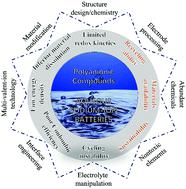当前位置:
X-MOL 学术
›
Energy Environ. Sci.
›
论文详情
Our official English website, www.x-mol.net, welcomes your feedback! (Note: you will need to create a separate account there.)
Assessment and progress of polyanionic cathodes in aqueous sodium batteries
Energy & Environmental Science ( IF 32.5 ) Pub Date : 2021-09-29 , DOI: 10.1039/d1ee01392k Huang Zhang 1, 2 , Xiaoping Tan 1, 2 , Huihua Li 3, 4 , Stefano Passerini 3, 4, 5 , Wei Huang 1
Energy & Environmental Science ( IF 32.5 ) Pub Date : 2021-09-29 , DOI: 10.1039/d1ee01392k Huang Zhang 1, 2 , Xiaoping Tan 1, 2 , Huihua Li 3, 4 , Stefano Passerini 3, 4, 5 , Wei Huang 1
Affiliation

|
Aqueous sodium-ion batteries are expected to be competitive technologies for large-scale energy storage applications due to the extraordinary sodium abundance, low manufacturing cost and high safety. However, only a few materials have been reported for the positive electrode and there is an urgent need to develop new, practical host materials with satisfactory performance. Polyanionic compounds [e.g., Na3V2(PO4)3] have shown promising performance as positive electrode materials in non-aqueous electrolyte-based sodium-ion batteries, yet they possess limitations in aqueous systems. Herein we provide an assessment of the materials along with the latest ground-breaking advances of polyanion-type compounds as potential positive electrode materials for aqueous sodium-ion batteries. Particular emphasis is placed on the electrolyte regulation and cell design to address the compatibility issues from the technical and scientific point of view, which would make aqueous sodium batteries advantageous over non-aqueous systems. Lastly, we provide an outlook on the challenges and research directions to incorporate polyanionic compounds in the development of high energy aqueous batteries for grid-scale applications.
中文翻译:

水性钠电池中聚阴离子正极的评价与进展
由于钠丰度高、制造成本低和安全性高,水系钠离子电池有望成为大规模储能应用的竞争技术。然而,关于正极材料的报道很少,迫切需要开发新的、实用且性能令人满意的主体材料。聚阴离子化合物[例如,Na 3 V 2 (PO 4 ) 3] 在非水电解质钠离子电池中作为正极材料显示出良好的性能,但它们在水性体系中存在局限性。在此,我们提供了对材料的评估以及聚阴离子型化合物作为水性钠离子电池潜在正极材料的最新突破性进展。特别强调电解质调节和电池设计,以从技术和科学的角度解决兼容性问题,这将使水性钠电池优于非水性系统。最后,我们展望了将聚阴离子化合物用于电网规模应用的高能水性电池开发中的挑战和研究方向。
更新日期:2021-10-22
中文翻译:

水性钠电池中聚阴离子正极的评价与进展
由于钠丰度高、制造成本低和安全性高,水系钠离子电池有望成为大规模储能应用的竞争技术。然而,关于正极材料的报道很少,迫切需要开发新的、实用且性能令人满意的主体材料。聚阴离子化合物[例如,Na 3 V 2 (PO 4 ) 3] 在非水电解质钠离子电池中作为正极材料显示出良好的性能,但它们在水性体系中存在局限性。在此,我们提供了对材料的评估以及聚阴离子型化合物作为水性钠离子电池潜在正极材料的最新突破性进展。特别强调电解质调节和电池设计,以从技术和科学的角度解决兼容性问题,这将使水性钠电池优于非水性系统。最后,我们展望了将聚阴离子化合物用于电网规模应用的高能水性电池开发中的挑战和研究方向。



























 京公网安备 11010802027423号
京公网安备 11010802027423号